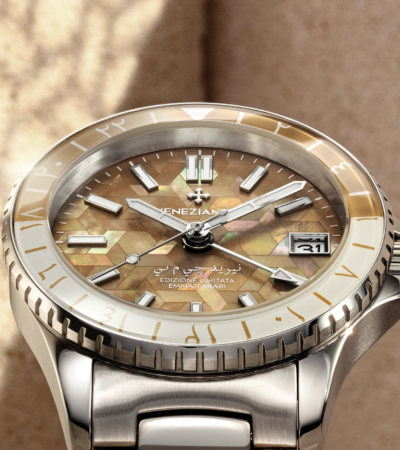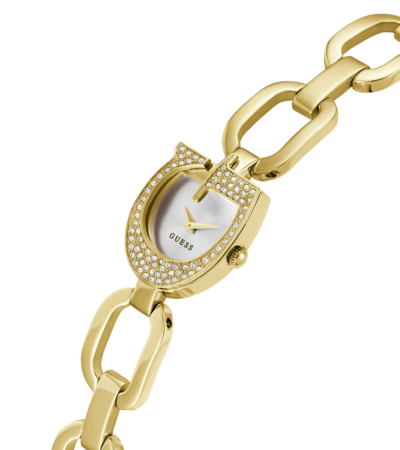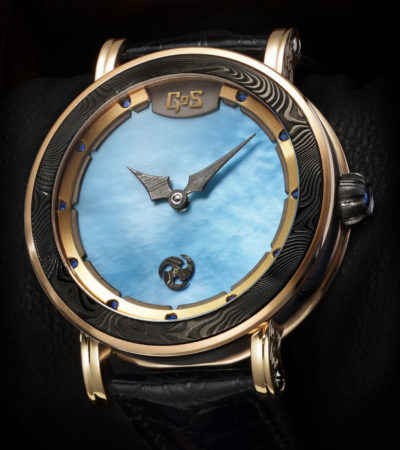
It swept the award board. It was a double winner at the 2014 Grand Prix d’Horlogerie de Genève in the prestigious “Mechanical Exception” and “Innovation” categories. It was crowned “Watch of the Year” by Revolution Asia and “Best of the Best” by Robb Report USA. It has been praised by the press, endorsed by Philippe Dufour and remains incredibly present in horological minds ten years after its creation.
To celebrate its decade in style, URWERK’s EMC – for Electronic Mechanical Control – has been reinvented clad in the fuselage of the legendary SR-71 reconnaissance aircraft!
The EMC is a mechanical watch whose concept and movement were envisioned, developed and created by URWERK in 2014. Its traditional functions – hours, minutes, seconds and power reserve – were complemented by an original, patented piece of information, the δ performance indicator. Thanks to this novel function, it is now possible, at the touch of a button, to assess the mechanical movement’s chronometric precision. This innovation made the EMC – Electro-Mechanical Control – the first mechanism to enable its wearer to measure their watch’s performance in real time. What’s more, armed with this information, they can adjust the setting of their watch to achieve the ultimate goal of perfect timekeeping. Watchmaking bliss at last within reach! The rest is history: a double win at the Grand Prix d’Horlogerie de Genève in two of its flagship categories, along with unanimous acclaim from the specialist press! From awards to recognition, it’s a great story and could have ended there.

December 2020. Two enthusiasts turn up at URWERK’s HQ in Geneva. Their names are Jason Sarkoyan and Dr Roman Sperl. The first is an experienced watch collector and designer, with the EMC Black on his wrist. The other is none other than Dr Roman Sperl, an aeronautical engineer and the specialist in the field of the SR-71 Blackbird, the fastest stealth aircraft ever built, capable of flying at Mach3+ (three times the speed of sound). Together they form Dreamland Aerospace*. They’re crazy about fine mechanics, they understand URWERK’s aspirations and above all, they share the same creative madness as the watch brand’s designers. They have come with an idea in mind, a slightly wild one of the very kind the Maison likes to explore: to celebrate the EMC’s 10th anniversary with an exceptional model combining the best of strategic reconnaissance aviation – the SR-71 Blackbird – with the best of EMC’s Haute Horlogerie concepts. They have a rare and priceless treasure in their possession: pieces of the SR-71 fuselage, made of titanium. The conversation quickly turns into freewheeling exchanges that would continue across time and distance, between Geneva, Zurich and New York. It would take three years before URWERK finally unveiled the EMC SR-71!
“It’s a bit of an insane story, yet at the same time, stories born of passion are the most beautiful, don’t you think?” enthuses Jason Sarkoyan. “I threw myself headlong into this adventure. All the more so because I could rely on the knowledge and experience of Dr Roman Sperl (“RoMiG21” on Instagram), a doctoral student at Munich Technical University and, above all, one of the world’s leading aeronautics experts.”

This EMC SR-71 is now available as a ten-piece limited series – 10th anniversary – 10 pieces – in a version enhanced by elements of the legendary aircraft’s fuselage. This “improved” titanium has been melted down and then worked to reincarnate itself as a charging crank for the EMC’s dynamo: “The layout of the screens composing the dial is reminiscent of the SR-71’s cockpit instruments, and not without reason”, explains URWERK’s artistic director and co-founder Martin Frei. “A watch, like an aircraft, is a machine that provides information about its performance. The watch face is a personal cockpit; in addition to the exact time, the EMC also provides information about how it works and how it is ‘piloted’. It’s a unique and exciting experience. My fascination with all things science fiction, space travel and aviation made me particularly keen to work on this project with Jason and Roman from Dreamland Aerospace.”
The EMC SR-71 thus takes on the appearance of an instrument panel with four separate dials, two of which feature screw-down bezels. The emphasis is on the seconds indicator (dial at 2 o’clock), the tip of which is designed like a stealth aircraft. It is one of the EMC’s flagship features, testifying to its smooth running and sense of precision. To its left – at 10 o’clock – the EMC’s performance is displayed in seconds per day, while its power reserve appears below at 7 o’clock. At 5 o’clock, the classic hours and minutes are indicated by a set of hands. On the back of the EMC, its in-house movement is visible beneath a sapphire crystal.
This in-house URWERK movement has been designed, developed and crafted in the URWERK workshops. Its performance is tested on four positions over a 30-day cycle to meet the most stringent standards for precision watches. “The SR-71 is a legendary aircraft, a competition beast designed to achieve the best performance. This is also the spirit in which we designed our EMC”, says URWERK’s master watchmaker and co-founder Felix Baumgartner. “These are two cutting-edge machines which, in order to perform at their best, need only to be steered by skilled hands.”
Its proven intrinsic qualities are based on the following characteristics:
- Its original balance was made from ARCAP, an alloy favoured by URWERK for its non-magnetic and anti-corrosive properties. Its distinctive morphology was carefully calculated to improve its aerodynamics and minimise disturbances caused by air friction. This enables it to maintain optimum amplitude.
- Its drive unit providing the power takes the form of an imposing double barrel vertically mounted on a single shaft. This series-coupled twin barrel ensures the EMC’s stable linear timing performance by endowing the EMC with an 80-hour power reserve.
- Its timing adjustment screw is accessible from the outside of the watch and enables extremely fine adjustments via the balance rate index regulator, by modifying the active length of the balance spring.
All that remained to enable observation and evaluation of this all-mechanical movement was to develop its electronic complication and monitoring device. Olivier Evalet, a software developer with a passion for software and computer engineering, was heavily involved in the project: “The idea was to use precision optics, i.e. light, to measure the performance of the mechanical movement. Using a 16,000,000 Hz mega-quartz as a reference, the measurements obtained are accurate to within ten microseconds.”
The EMC control function is composed as follows:
- An optical sensor linked to the balance wheel.
This sensor consists of a transmitter and a receiver positioned on either side of the balance. Its role is to record the oscillations of this organ operating at 28,800 vph (4 Hz) over a period of three seconds. This measurement is triggered manually by pressing a start button.
- A 16,000,000 Hz electronic oscillator
This provides the EMC’s benchmark timing rate. The performance of the EMC balance (4 Hz) is compared against this extraordinary oscillator to obtain the most accurate possible measurement.
- An integrated circuit
This calculator is capable of determining the differential (symbolised by the letter δ) between the movement’s timing rate and that of the reference oscillator. Each microsecond difference between the two values is expressed as a gain or loss of a second per day of the movement’s timing rate. A variation of 0.0000014 of a second per half-vibration translates as a variation of one second per day.
- A manual-winding generator:
The EMC’s monitoring unit (the optical sensor and the computer) is powered by a micro-generator made by Swiss company Maxon, famous for having developed the electromotors equipping the Mars rovers for NASA’s Pathfinder probe.
“EMC is an ode to the mechanical watch and to the watchmaker’s craft”, explains Felix Baumgartner, master watchmaker and co-founder of URWERK. “The mechanical watch is a sensitive organism and its movement’s timing rate fluctuates according to several parameters”, he continues. “These changes of pace and performance are perceptible to the watchmaker, who has all the equipment necessary for testing the accuracy of the movement. An amateur rarely has these tools. With the EMC, we give them the opportunity to dive into the heart of their watch, to see it live and evolve. “

Therein lies the entire concept behind the EMC. This new kind of mechanical watch has a threefold objective:
- show the influence of external parameters (activity, temperature, pressure) on the balance-spring mechanism;
- correct these timing variations at source, provide flexibility and achieve the best possible chronometric performance;
- enable exchanges and encourage interactivity between a timepiece and its owner, as the wearer of the watch also becomes its precision timer.
“This EMC adopts the bold design and matte black fuselage of the legendary SR-71 Blackbird. This prestigious collaboration is the perfect blend of horological excellence and aeronautical engineering. The new edition of the EMC not only measures time with unrivalled precision, it also captures the SR-71’s spirit of speed and stealth. It’s a unique and exhilarating experience”, explains URWERK’s co-founder and artistic director Martin Frei.

Watchmaking bliss, enhanced by the power and elegance of the SR-71, is finally within reach. URWERK invites you to discover this limited edition, a symbol of innovation and perfection!
Technical specifications
EMC SR-71 (limited edition of 10)
| Case | |
| Material: | Titanium and steel
|
| Crank handle in SR-71 alloy
(titanium; aluminium; vanadium; silicon; iron and molybdenum)
|
|
| Dimensions:
Dimensions : |
Width 47.55mm; length: 49.57mm; thickness: 17.58mm |
| Crystal: | Crystal sapphire |
| Water resistance | Pressure tested to 30m / 3ATM |
| Finishing: | Shot-blasting |
| Movement | |
| Caliibre: | UR-EMC; in-house URWERK movement |
| Escapement: | Swiss lever escapement |
| Balance: | ARCAP P40; URWERK balance coupled with optical sensor |
| Frequency: | 28,800 vph – 4 Hz |
| Balance spring: | Flat |
| Energy source: | Vertically mounted series-coupled double mainspring barrels |
| Power reserve: | 80 hours |
| Winding: | Manual winding |
| Finishing: | Côtes de Genève; snailing; micro bead-blasting; chamfered screw heads |
| Artificial intelligence | |
| Generator: | Manual-winding Maxon® generator |
| Monitoring organ: | Optical sensor linked to the mechanical balance; 16,000,000 Hz electronic oscillator oscillator |
| Indications | Hours; minutes; seconds; δ performance indicator (patented); power reserve; timing adjustment screw. |
| Strap | NATO strap (nylon, leather) inspired by aeronautical safety straps. Velcro fastening. |
| Price | CHF 150,000 (Swiss francs / exclusive of tax) |















